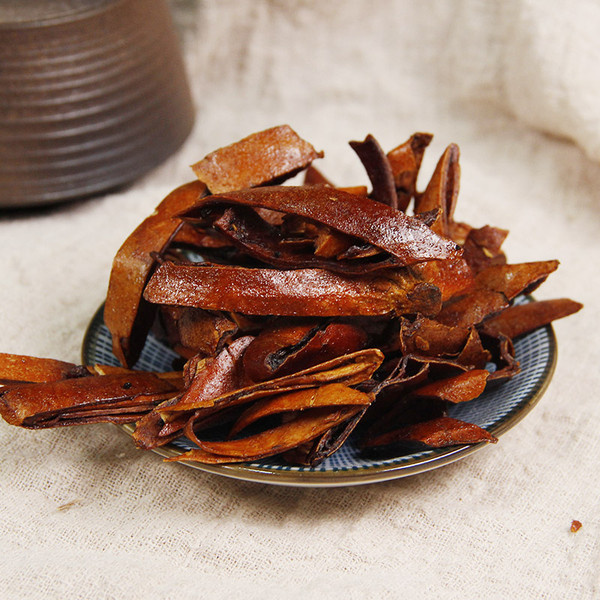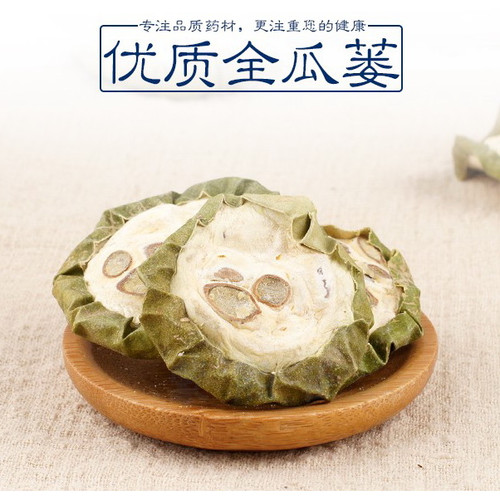Product Overview
Parts used: Dried fruit
TCM category: Cool herbs that transform Phlegm and stop Cough
TCM nature: Cold
TCM taste(s): Sweet
Meridian affinity: Stomach Large intestine Lung
Scientific name: Trichosanthes kirilowii or Trichosanthes rosthornii
Other names: Trichosanthes fruit
Use of snake gourds (Gua Lou) in TCM
Please note that you should never self-prescribe TCM ingredients. A TCM ingredient is almost never eaten on its own but as part of a formula containing several ingredients that act together. Please consult a professional TCM practitionner, they will be best able to guide you.
Preparation: Dry the fruit by hanging in a ventilated place
Dosage: 6 - 18 grams
Main actions according to TCM*: Clears Phlegm-Heat conditions with thick difficult to expectorate sputum. Regulates the Qi of the chest and relieves constriction and swellings of the chest and Lungs. Lubricates the Intestines.
Primary conditions or symptoms for which snake gourds may be prescribed by TCM doctors*: Phlegm Sputum Coughing Angina Chest congestion Mastitis Lung abscess Appendicitis Constipation
Contraindications*: Should not be used by those with Cold and Damp especially when there is Spleen Deficiency.
Common TCM formulas in which snake gourds are used*:
For mastitis combine snake gourds with maral roots (Lou Lu) and dandelions (Pu Gong Ying).
For Wind-Heat cough combine snake gourds with platycodon roots (Jie Geng), mulberry leaves (Sang Ye) and apricot seeds (Xing Ren).
For feverish diseases with symptoms of thirst and irritability combine snake gourds with common reed rhizomes (Lu Gen), gypsum (Shi Gao) and dwarf lilyturf roots (Mai Dong).
For angina combine snake gourds with long-stamen onion bulbs (Xie Bai) and cinnamon twigs (Gui Zhi).
For aiding in the withdrawal from tobacco addiction combine snake gourds with houttuynia (Yu Xing Cao), ginseng (Ren Shen), mulberry bark (Sang Bai Pi) and platycodon roots (Jie Geng).
For loosen phlegm in the chest and mobilize Yang combine snake gourds with scallions (Cong Bai).
For cough with thick yellow phlegm combine snake gourds with anemarrhena rhizomes (Zhi Mu) and baikal skullcap roots (Huang Qin).
Key TCM concepts behind snake gourds (Gua Lou)'s properties
In Traditional Chinese Medicine (TCM), snake gourds are plants that belong to the 'Cool herbs that transform Phlegm and stop Cough' category. In TCM Phlegm is a condition of Stagnation of Fluids which tends to start in the Spleen and then goes to the Lungs. If this overly accumulates it thickens and becomes pathological Phlegm. Phlegm, being a form of Stagnation, often starts as being Cool and transforms to Hot as the condition progresses. The herbs in this category are Cold in nature so they treat the later stages of the Stagnation: Hot and Dry-Phlegm with symptoms such as cough, goiter or scrofula.
As suggested by its category snake gourds are plants that are Cold in nature. This means that snake gourds typically help people who have too much "heat" in their body. Balance between Yin and Yang is a key health concept in TCM. Those who have too much heat in their body are said to either have a Yang excess (because Yang is Hot in nature) or a Yin deficiency (Yin is Cold in Nature). Depending on your condition snake gourds can help restore a harmonious balance between Yin and Yang.
Snake gourds also taste Sweet. The so-called "five elements" theory in Chinese Medicine states that the taste of TCM ingredients is a key determinant of their action in the body. Sweet ingredients like snake gourds tend to slow down acute reactions and detoxify the body. They also have a tonic effect because they replenish Qi and Blood.
The tastes of ingredients in TCM also determine what organs and meridians they target. As such snake gourds are thought to target the Stomach, the Large intestine and the Lung. In TCM the Stomach is responsible for receiving and ripening ingested food and fluids. It is also tasked with descending the digested elements downwards to the Small Intestine. The Large Intestine on the other hand receives the "impure" parts of the digested food from the Small Intestine, absorbs the remaining fluids and excrete the remainder as feces. In addition to performing respiration, the Lungs are thought to be a key part of the production chain for Qi and the body fluids that nourish the body.
Use of snake gourds (Gua Lou) as food
Snake gourds are also eaten as food.








